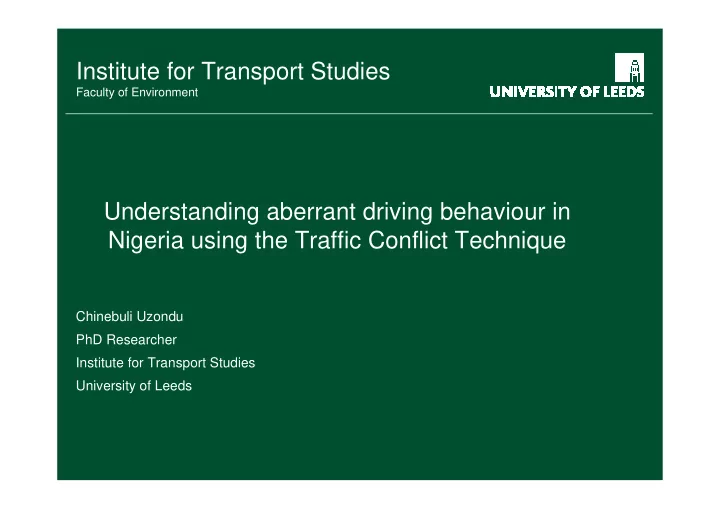

Institute for Transport Studies Faculty of Environment Understanding aberrant driving behaviour in Nigeria using the Traffic Conflict Technique Chinebuli Uzondu PhD Researcher Institute for Transport Studies University of Leeds
Background � Road traffic fatality rates in developing countries are more than double those in developed countries (WHO, 2015) � Africa region has the highest estimated road traffic fatality rate of 26.6 per 100,000 population (WHO, 2015) � WHO (2013) recorded Nigeria as having the highest fatality rate of 33.7 per 100,000 population in Africa. � Data for research is scarce and not available � Empirical research and quality data recommended for intervention purposes
Accident data Accident data used over the years has proved very beneficial but its present usefulness is limited due to Probable % number Non causes of road of crashes traffic crash caused availability Extended Speed Inadequate Inadequate 26.5 of data observation Violation information information time Loss of Control 22.9 Dangerous 9.4 Driving Accident Sign light 9.1 violation Tyre burst data 6.7 Wrongful 4.5 overtaking Routes 4.3 violation Quality and reliability Brake failure 4.0 of available data Dangerous 1.8 overtaking Others 10.8
A potential solution Due to an urgent need to improve safety of road users especially in developing countries •Traffic conflict Technique in addition to •Onsite behavioural observation could offer a solution. •Shorter time •Gives information and idea of processes •Inexpensive and locally available resources could be used •Readily applied to identify specific traffic problems and interventions developed to tackle such problems
Study Objective To understand the underlying factors which contribute to unsafe driving behaviour in Nigeria •by comparing different road users •at different road layouts (signalised, Un signalised and link) •during peak and off peak hours •using observational, non-crash data
Methodology Conflict studies • - Manual and video recording - Swedish Traffic Conflict Technique (severity level based on speed and time to accident at the start of evasive manoeuvre) Behavioural observations • - Speed - Behavioural measures (overloading, eating/drinking, seat belt off, cell phone and head phone use) - Give way violations (vehicles moving into major traffic stream without slowing down)
Methodology • Data collected during June-July 2016 • Observation time: 7.30-9.00 (peak); 11:00-12:30 (off peak) • Camera recording: 3hours a day for 7days; traffic volume was counted from recordings • Observation of behaviour and speed measurement made at site during observation time • Focus of observation: - Motor vehicles - Tricycles - Pedestrians
Study Location Due to time limitations, focus will be on an: •Un signalised four arm intersection •Mixed traffic (Vehicles, tricycles, pedestrians) Major road Major road •Speed limit 50km/hr •Manual and video •Six observers (two: conflict recording; two: speed measurement; two: behavioural observation).
Results - Conflicts
Results - Conflicts
Short video of conflict situation 1
Short video of conflict situation 2
Short video of conflict situation 3
Results – Behavioural Observation Vehicles Tricycles Peak Off peak Peak Off peak (%) (%) (%) (%) Seatbelt off 52.7 46.0 - - Cell phone use 1.84 1.88 0.02 0.18 Eating/drinking 0.04 0.06 - 0.22 Headphone use 0.04 0.07 0.08 0.11 Overloading 0.82 1.05 54.7 19.3 Give way 27.7 57.7 23.1 38.72 violation Speed violation 3 28 - -
Results – Behavioural Observation Of all unsafe behaviours recorded, the most prevalent are shown below:
SUMMARY Conflict situations: •Frequency of vehicle-vehicle conflicts higher during the peak period. Contributing factors: Higher traffic density, insufficient traffic regulation/enforcement •Whereas the off peak period had more vehicle-tricycle, vehicle-pedestrian and tricycle- tricycle conflicts compared to the peak period. Contributing factors: low traffic volume leading to slightly higher speed, give way violations, vehicles not yielding to tricycles and no traffic regulation •No tricycle-pedestrian conflict was observed during the off peak period. Contributing factors: low pedestrian density
SUMMARY Behavioural observation •Peak period recorded more: Seatbelt violations (vehicles); Overloading (tricycles) •Off peak period: Higher frequency of give way violations; Vehicles exceeding the speed limit
Summary • Vehicles do not often slow down while approaching the intersection especially during off peak hours. • Vehicle drivers do not often give way to tricycles even when they (tricycles) had priority • There is confusion about priority which is not properly defined • Seatbelt compliance rate is very low Intervention: Better education including enlightenment programmes and campaigns, training and retraining. • Pedestrian paths and crossing not provided • Speed limits, priority and right of way not properly defined and posted Intervention: Engineering/Infrastructure including better signage, and traffic calming measures. • Traffic regulations not usually obeyed Intervention: Better, more effective and stricter regulations and enforcement.
Next steps • Detailed comparison with other locations to identify additional unsafe behaviours and risky road locations • Comparison with the UK and foreign drivers
Thanks for your attention! Chinebuli Uzondu tsccu@leeds.ac.uk
Recommend
More recommend